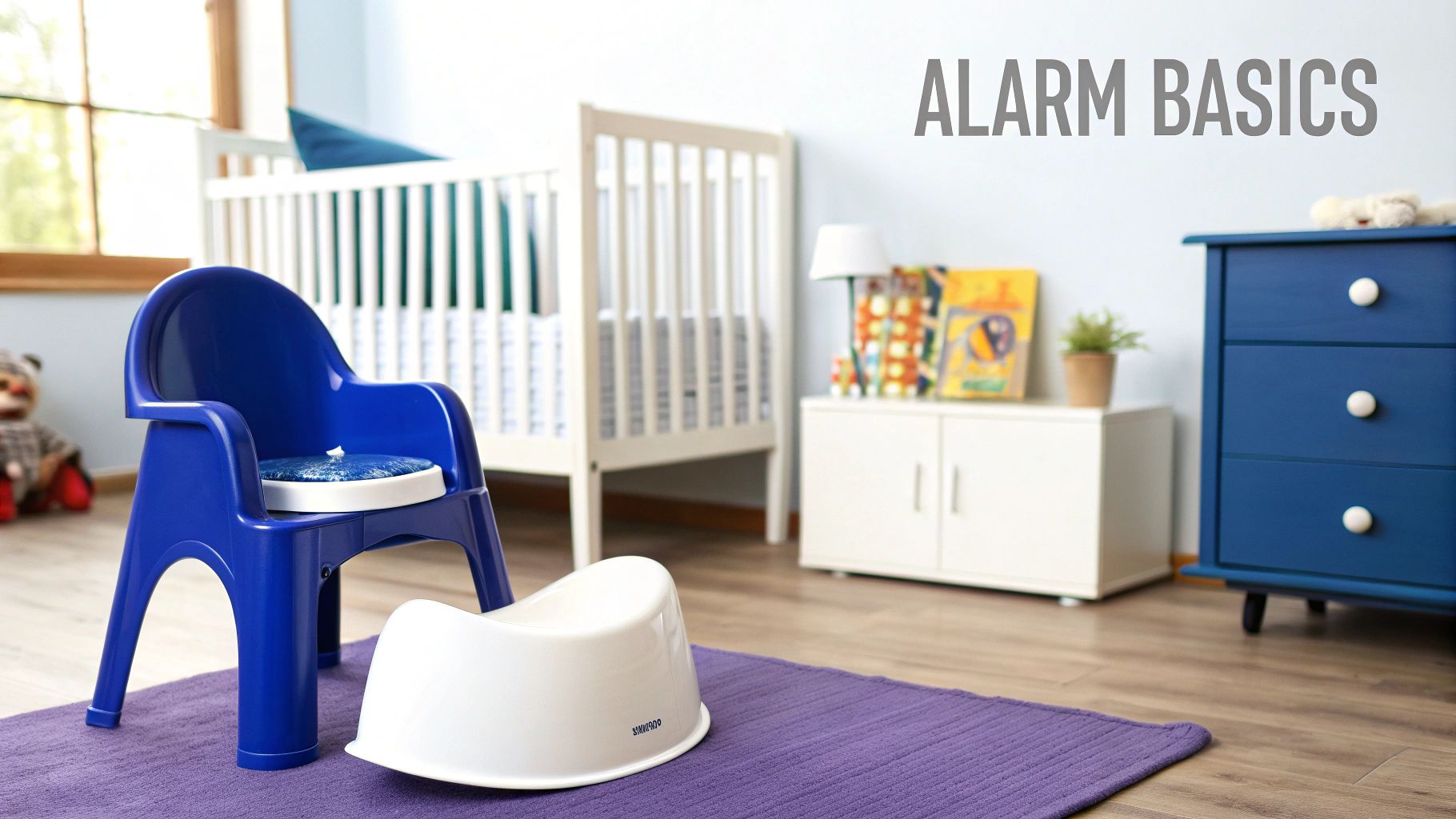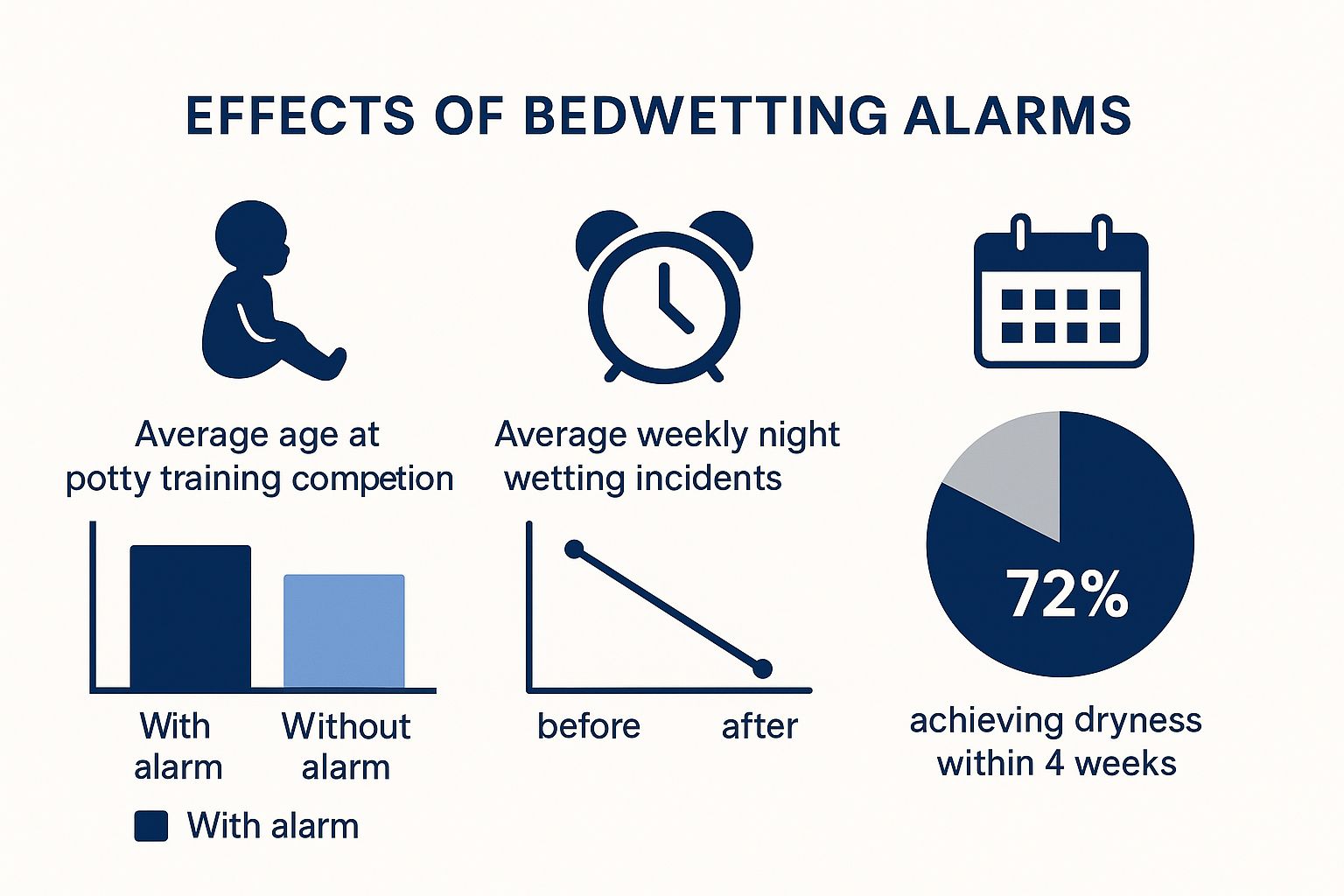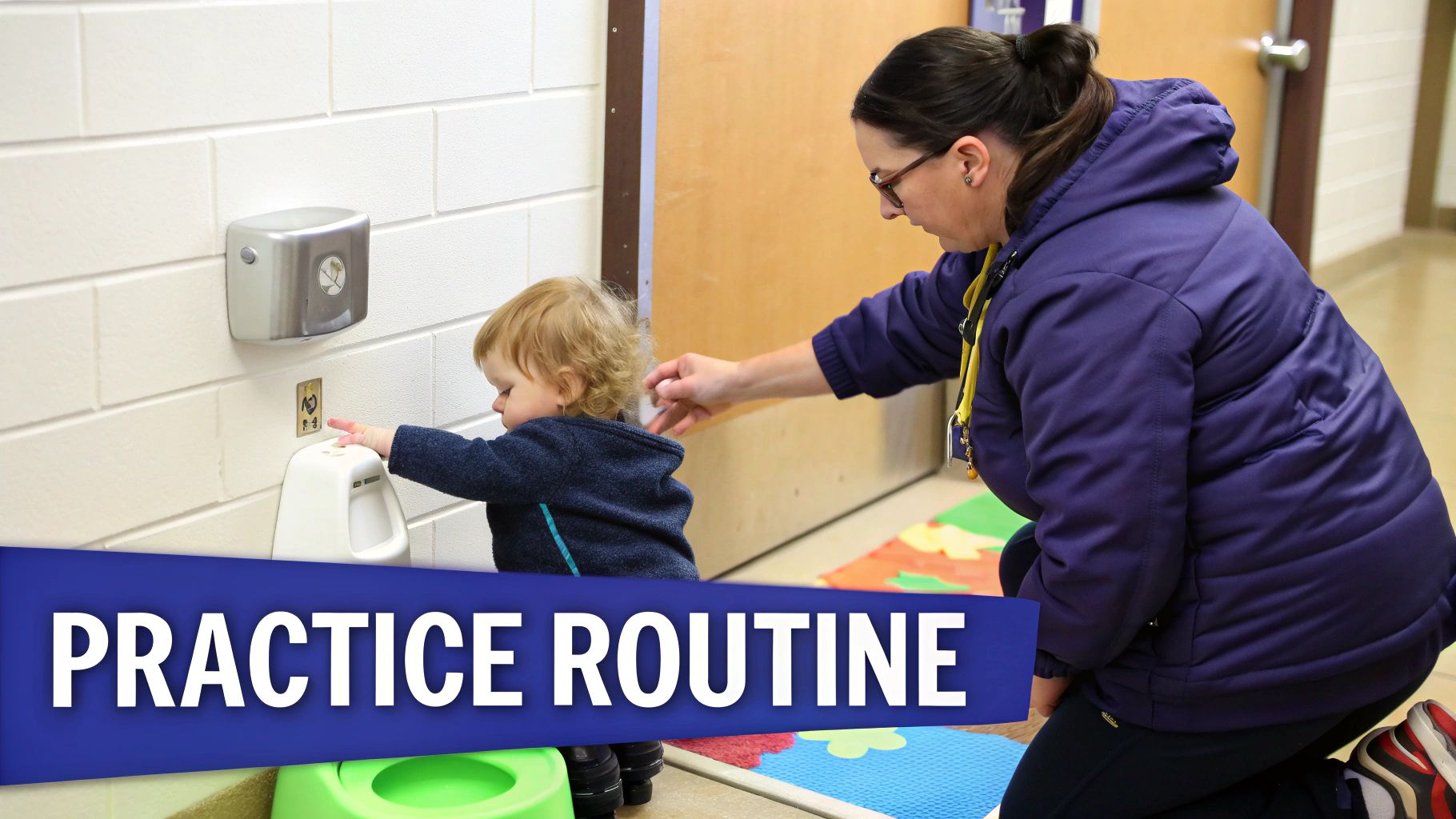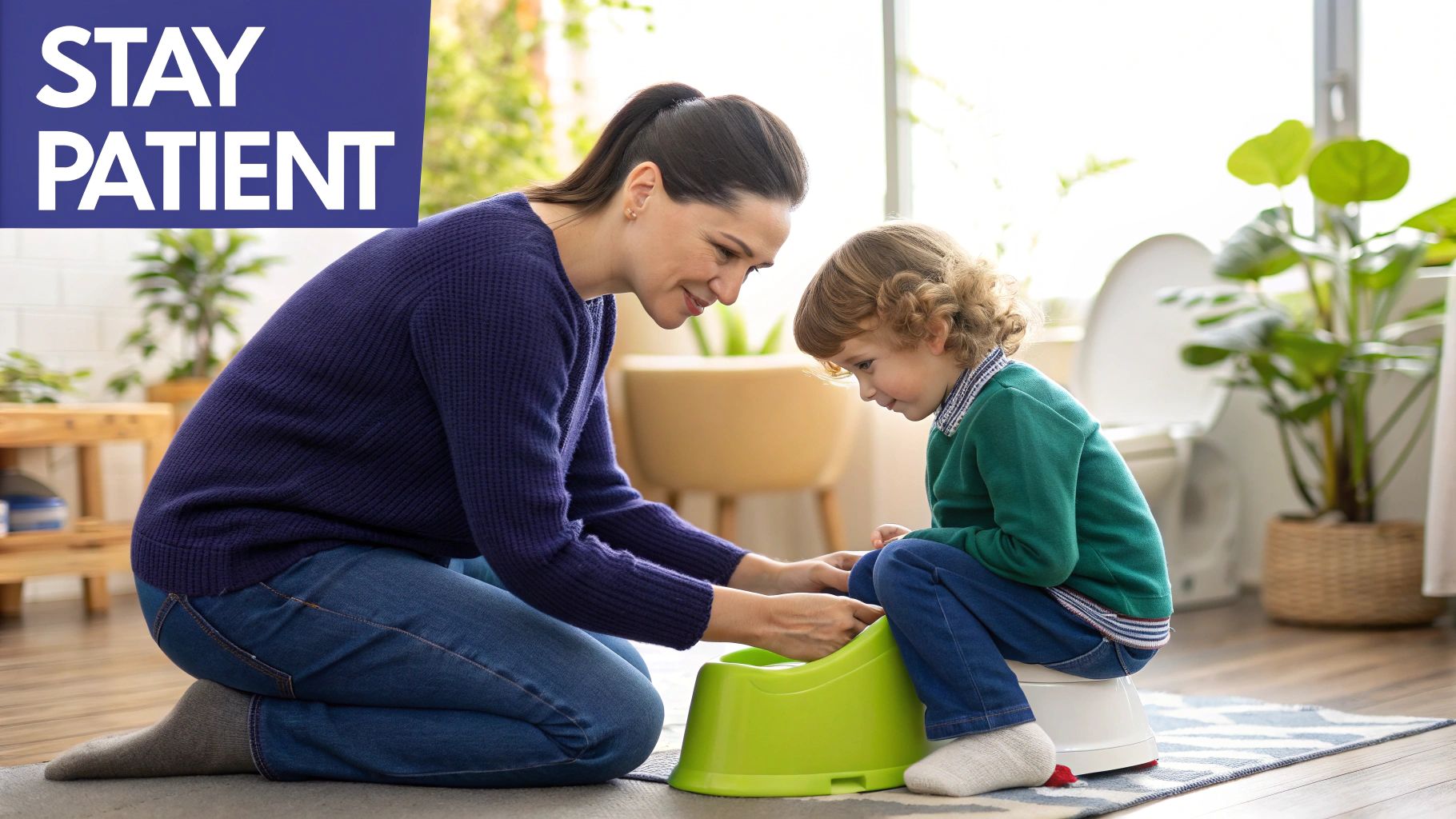Why Potty Training Alarms Actually Work When Other Methods Don't
 If you've celebrated daytime potty wins only to face the nightly challenge of wet sheets, you're definitely not alone. It's a common struggle that leaves many parents wondering what they're doing wrong. The truth is, daytime potty control and nighttime dryness are two very different skills. While going to the potty during the day is a conscious decision, staying dry overnight is an unconscious process. It requires the brain to learn a new trick: waking up when the bladder says it's full.
If you've celebrated daytime potty wins only to face the nightly challenge of wet sheets, you're definitely not alone. It's a common struggle that leaves many parents wondering what they're doing wrong. The truth is, daytime potty control and nighttime dryness are two very different skills. While going to the potty during the day is a conscious decision, staying dry overnight is an unconscious process. It requires the brain to learn a new trick: waking up when the bladder says it's full.
This is exactly where a potty training alarm can make a huge difference. This isn't about punishing accidents or setting disruptive alarms to wake your child every couple of hours. Instead, it’s a gentle and effective form of behavioral conditioning.
How Alarms Rewire the Brain for Dry Nights
Think of it this way: your child’s brain is currently sleeping right through the signal their bladder is sending. The potty training alarm acts like a helpful interpreter. The second the sensor detects any moisture, the alarm goes off, waking your child (and let's be honest, you too). This consistent interruption forges a direct link between the physical feeling of a full bladder and the action of waking up. Over time, the brain begins to recognize that signal all on its own, well before the alarm is ever needed.
The real aim isn’t just to catch an accident as it happens; it's to train that brain-bladder connection to work automatically during sleep. This is why children who are already staying dry for 2-3 nights a week are often perfect candidates for this method. They're so close to mastering the skill, and the alarm gives them that final, helpful nudge.
The Science-Backed Choice for Families
This approach is so successful that pediatric specialists often recommend it as a first-line, non-invasive treatment for bedwetting. The trust in this method is clear when you look at the market; the global bedwetting alarm market was valued at around $320 million in 2023 and is expected to continue growing. This isn't just another gadget; it's a proven tool that bridges a key developmental gap, which is what sets it apart from other potty training methods that only focus on daytime habits.
Finding Your Perfect Potty Training Alarm Match
Picking out a potty training alarm can feel like a big deal, but it really comes down to matching the right gadget to your child's personality and sleep habits. What works wonders for your friend’s kid might just be a frustrating noisemaker in your home. The real goal is finding an alarm that helps build that brain-bladder connection without making your nights even more stressful.
Wearable vs. Bedside: Which Is Better?
When you start looking, you'll see two main types: wearable alarms and bedside alarms.
A wearable alarm is the most common type. It involves a tiny sensor that clips right onto your child's underwear. This sensor is connected by a thin wire (or wirelessly, in some models) to an alarm unit worn on their pajama top. They’re super sensitive and go off the instant they detect moisture, which is exactly what you need for this process to work. They are a fantastic choice for kids who toss and turn all night.
A bedside alarm, on the other hand, uses a special moisture-sensing mat that you place under the bedsheet. When the mat gets wet, it triggers an alarm unit sitting on the nightstand. While this means no wires on your child's body, they can sometimes be less sensitive. If your child is wearing thick pajamas or doesn't wet the bed in the exact spot where the sensor is, the alarm might be delayed or not go off at all.
For most families, we find a wearable alarm offers the most immediate and reliable feedback necessary for effective training.
Features That Genuinely Matter
Once you've decided between wearable and bedside, it's time to look at the details. The alarm's sound and sensitivity are huge. An alarm that's too quiet won't wake a deep sleeper, but one that sounds like a fire drill can be genuinely scary for a little one. Look for models that offer a mix of sound, vibration, and even light, so you can figure out what works best to wake your child gently but effectively.
Adjustable sensitivity is another must-have feature. This helps prevent false alarms caused by sweat on a warm night, which can quickly make everyone lose faith in the process.
To help you sort through the options, here’s a quick comparison of the two main alarm types.
Comparison of Popular Potty Training Alarm Types
Side-by-side comparison of wearable vs bedside alarms, including features, price ranges, and best use cases
| Alarm Type | Best For | Key Features | Price Range | Pros | Cons |
|---|---|---|---|---|---|
| Wearable Alarm | Active sleepers, deep sleepers, and families wanting the fastest results. | Small sensor clips to underwear; alarm unit worn on pajamas. Options for sound, vibration, and light. | $30 - $80 | Highly sensitive and detects moisture instantly. Portable for travel. | Some children may find wearing the device slightly uncomfortable at first. |
| Bedside Alarm | Children who are sensitive to wearing devices or those who sleep relatively still. | Moisture-sensing mat placed under the sheet; separate alarm unit on the nightstand. | $60 - $150 | Nothing to attach to the child's body. Can cover a larger area of the bed. | May be less sensitive or have a delayed reaction. False alarms if the mat shifts. |
Ultimately, both types can be effective, but wearable alarms tend to offer the direct, immediate feedback that is so important for conditioning the brain to wake up.

As you can see, choosing the right alarm can make a real difference in how quickly your child achieves dry nights. To see how this tool fits into the complete potty training journey, you can learn more in our potty training ultimate guide.
Setting Up Your System for Real Success
 Getting your new potty training alarm out of the box feels like a big step, but the real win comes from setting it up thoughtfully. The instruction manual covers the basics, but a few parent-tested tricks can be the difference between a dry night and a frustrating false start. It’s not surprising that these alarms are becoming more common; the market was valued at USD 407.8 million in 2023 and continues to grow. For more information on this trend, you can discover more insights about bedwetting alarm solutions at Data Insights Market.
Getting your new potty training alarm out of the box feels like a big step, but the real win comes from setting it up thoughtfully. The instruction manual covers the basics, but a few parent-tested tricks can be the difference between a dry night and a frustrating false start. It’s not surprising that these alarms are becoming more common; the market was valued at USD 407.8 million in 2023 and continues to grow. For more information on this trend, you can discover more insights about bedwetting alarm solutions at Data Insights Market.
Nailing the Sensor Placement
Where you put the sensor is everything. Don’t just clip it randomly on the underwear. For the alarm to work the moment it needs to, you have to place it right at the "point of first wetness." This is the spot where the first drop of urine will land.
- For boys: The best spot is usually right at the front of their close-fitting underwear or pull-up.
- For girls: You'll likely have more success placing it a bit further down in the crotch area.
A common pitfall is letting your child wear loose-fitting pajamas. The sensor has to stay snug against the fabric to detect moisture right away. If it’s dangling or loose, it won’t work correctly, and you might have a full-blown accident before the alarm even has a chance to sound.
Optimizing the Alarm Unit
With the sensor secured, turn your attention to the alarm unit itself. If you have a wearable model, clip it to your child’s pajama collar, close to their ear. This positioning ensures they both hear and feel the vibration, which is key for rousing a deep sleeper. If you’re using a bedside alarm, put it on a nightstand where it won’t get muffled by pillows or blankets.
Before you even attempt the first night, do a quick "drip test." Take the sensor and carefully put a single drop of water on it. Did the alarm go off instantly? Was the volume and vibration setting noticeable enough to be alerting, but not so loud that it's terrifying? Testing and adjusting these settings before your child is asleep is crucial. This simple check can save you from fumbling with the device at 2 AM and helps build everyone's confidence in the new system.
Building The Bedtime Routine That Makes Everything Click
The potty training alarm itself is just a tool. The real magic happens when you build a consistent and positive routine around it. A predictable wind-down ritual helps your child feel secure and prepared, turning what could be a stressful task into a fun team mission. This is about more than just cutting off drinks before bed; it's about creating an empowering end to the day.
Start by introducing the potty training alarm in a fun way. Call it their "nighttime helper" or a "special superhero gadget" that helps them listen to their body even while they're asleep. You could say something like, "This little helper will wake you up if your body needs to go potty, and soon you'll learn to wake up all by yourself!"
Crafting Your Pre-Sleep Ritual
A solid routine is your best friend for reducing anxiety and setting your little one up for a dry night. Here’s a simple flow that many parents find incredibly effective:
- Final Drink: Offer the last small drink of water about 60-90 minutes before you turn out the lights. It's a good idea to skip sugary drinks or milk right before bed, as they can make the bladder work overtime.
- The "Double Void": This little trick can be a game-changer. Have your child use the potty about 30 minutes before bed. Then, make one more trip right before you tuck them in. You might be surprised how often they can go again!
- Gear Up Together: Make attaching the sensor a normal part of getting into pajamas. When you let your child help clip it on, you give them a sense of control and ownership. It becomes their special tool, not some weird medical device.
A huge part of a successful potty training journey is keeping the sleeping area clean and dry, which reduces stress for everyone. Investing in a quality waterproof mattress protector can make accidents a non-issue. It makes clean-ups fast and keeps the focus on encouragement and success.
Surviving The First Month Without Losing Your Mind

Let's be brutally honest: the first month of using a potty training alarm can feel like a marathon of broken sleep and endless laundry. This is where your commitment gets tested. You'll likely have nights with false alarms, nights where your child sleeps right through the sound, and discouraging moments where it feels like you're moving backward. This is all part of the journey. The secret is aiming for consistency over perfection.
Fine-Tuning on the Fly
Think of that first week as your data collection phase. You might quickly discover your child sleeps like a rock and the vibration-only setting you started with just isn't cutting it. Don’t be afraid to adjust as you go. Try adding the audible alarm or even moving the alarm unit closer to their ear. Some parents find that an alarm with multiple tones works wonders, as their child might get used to one sound but is roused by a new one.
It’s also crucial to manage your own expectations. Most children need 3-4 weeks to start showing consistent progress, with many taking up to 3 months to achieve reliable nighttime dryness. Discouragement is the biggest threat to success. You will have good nights and bad nights. The goal is to stay calm, be supportive, and stick to the routine no matter what.
A Roadmap for Progress
Setbacks don't mean failure; they're just part of the learning curve. If after two weeks you see absolutely zero change in your child's awareness of the alarm, that's a good signal to re-evaluate your alarm's settings or placement. To help you navigate this period, we've put together a tracking guide. It breaks down what you can generally expect week by week.
Weekly Progress Tracking Guide
What to monitor and record during the first month of using a potty training alarm
| Week | Expected Milestones | Common Challenges | Adjustment Tips | Success Indicators |
|---|---|---|---|---|
| Week 1 | Child becomes aware of the alarm. May wake up after already starting to urinate. | Sleeping through the alarm. Fear or confusion about the noise. False alarms. | Increase volume/vibration. Do "fire drills" during the day to practice reacting. Check sensor placement. | Waking up, even if wet. Talking about the alarm during the day. |
| Week 2 | Begins to associate the alarm with the need to go potty. May start waking up sooner. | Frustration (from both parent and child). Inconsistent waking. | Stick to the routine. Offer praise for any success. Try a different alarm tone if available. | Waking up right as urination begins. Fewer completely soaked nights. |
| Week 3 | Starts waking up to the alarm consistently and getting to the potty. Some may even wake up before the alarm. | "Accidents" on nights after a few dry nights (regression). Tiredness affecting daytime behavior. | Stay positive and consistent. Reassure your child that accidents happen. Ensure a consistent bedtime. | First completely dry night. Waking up on their own to use the toilet. |
| Week 4 | More frequent dry nights. Increased confidence and independence in getting up to use the toilet. | Overconfidence leading to forgetting the routine. Occasional accidents when overly tired. | Celebrate the dry nights! Gently remind them of the process. Discuss "listening to your body." | Several consecutive dry nights. Child expresses pride in staying dry. |
Remember, every child's timeline is unique. This table is a guide, not a strict schedule. Your role is to be the consistent, encouraging coach on the sidelines. For more parent-tested strategies to help you through the tough nights, check out our guide on night potty training tips for some extra support and encouragement.
Troubleshooting Problems That Stump Most Parents
Even with the perfect alarm and a solid bedtime routine, you'll likely hit a few bumps on the road to dry nights. That's perfectly okay. The trick is to stay calm and put on your detective hat to figure out what little adjustments your potty training alarm needs.
When the Alarm Misbehaves
It’s a common frustration: an alarm that seems to have a mind of its own. If your child is getting false alarms from sweat, try tucking a small, thin piece of tissue paper between the sensor and their underwear. This can absorb that minor moisture and stop the alarm from going off unnecessarily. On the other hand, if the alarm isn't sounding during an accident, double-check that the sensor has a snug fit. Loose pajama bottoms are often the culprit here.
Another challenge you might run into is your child instinctively taking off the alarm in their sleep. This is usually just a subconscious reaction, not a deliberate act. To work around this, you can try a few things:
- Use two-piece pajamas and run the alarm's cord underneath the pajama top.
- Secure the sensor with a small piece of medical tape, but always do a spot test on their skin first to check for any sensitivity.
- Practice together by making it part of the bedtime routine. Putting the alarm on with your child every night helps build familiarity and makes it less of a foreign object to them.
Dealing with Deep Sleepers and Regression
What if your little one could sleep through a marching band in their bedroom? For those extra deep sleepers, sound alone might not be enough to wake them. This is where alarms with a strong vibration feature are a game-changer. Position the vibrating unit on their collarbone, where they're most likely to feel it. You can also look for models with different alarm sounds; sometimes, a new or different tone is all it takes to cut through their sleep cycle.
Regression can also feel like a huge setback. After a wonderful string of dry nights, a sudden accident can be tough on everyone's morale. Don't panic. This is a completely normal part of learning a new skill. Often, it's caused by something simple like being overtired, feeling a little under the weather, or a change in routine. Just reassure your child, stick with your positive system, and treat it as a minor bump in the road.
The need for effective tools is exactly why the market for potty training aids is so significant. The global market was valued at an estimated USD 743 million in 2022, which shows just how many families are looking for these kinds of solutions.
Celebrating Real Success And Building Lasting Confidence
After what feels like an eternity of midnight alarms and sleepy walks to the bathroom, seeing a long streak of dry nights is a massive win. The whole point, after all, is to eventually ditch the potty training alarm and help your child learn to trust their own body. Knowing when to declare victory and begin phasing out the alarm is crucial for building real confidence and avoiding any frustrating steps backward.
Knowing When You've Crossed the Finish Line
The magic number you're aiming for is 14 consecutive dry nights. This isn't just a lucky week; it’s a clear signal that their brain-to-bladder connection has clicked into place. They are consistently waking up on their own, before the alarm even has a chance to go off. This is the moment to start celebrating their incredible achievement.
Once you’ve hit that two-week milestone, it's time to let go of the tech. A slow and steady transition works best to keep things positive:
- Switch to vibration only: For the next seven nights, turn off the sound. This is a great test to see if they respond to a much gentler nudge.
- Go device-free: If they ace the vibration-only week, you can officially retire the alarm. They've earned it!
From External Cues to Internal Trust
This transition is a huge confidence booster for your little one, so treat it like a graduation day. You can say something like, "You've done such an amazing job listening to your body that you don't even need your special helper anymore!" This simple phrase helps shift their focus from relying on a gadget to trusting their own internal cues. It’s empowering.
Of course, a random accident might still pop up, especially if your child is sick, extra tired, or had a big day. Just handle these moments with the same calm, reassuring attitude you've used throughout this journey. This whole process is a major accomplishment, proving to your child (and you!) that they can conquer big challenges.
Ready to start your own success story? The path to dry nights is a big step, but with the right approach and support, you can give your little one confidence that will stick with them. Explore the supportive, parent-designed solutions at Benny Bradley's to make your potty training journey a success.
